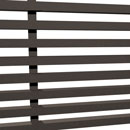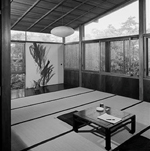
Slat
Slat describes screens composed of regularly spaced thin strips of material, typically wood, and oriented in either a horizontal or vertical direction. more
Slat | Material
research
A variety of cultures living in hot, humid regions use slatted screens to mitigate the effects of the sun. Lightweight and easily constructed, such screens are composed of thin strips of wood evenly spaced along a frame in either the horizontal or vertical direction. Slatted screens provide relief from the sun's direct rays, while still allowing the passage of air through small openings.
In Moroccan cities, wood-slatted roofs cover outdoor markets keeping merchants and shoppers cool and shaded. In traditional Japanese architecture, wooden lattice windows made with removable vertical slats serve as one of a series of layers easing the transition between indoors and out.1 Japanese traditions inspired the work of American architect Frank Lloyd Wright who also used slatted window treatments. For the office he designed for Edgar Kaufmann in 1937, Wright covered a wall of windows with horizontal cypress louvers. Years earlier Wright designed his famous high-backed dining chairs, emphasizing their height with a slatted back made from slender vertical strips rising from the floor.
Another influence on this archetype comes from the construction of barns, especially those built using balloon frame construction. The shift from timber frame to balloon frame construction occurred in response to the industrialization of lumber and machine-made nails. During the 1820s, milling operations developed more sophisticated ways of cutting lumber using water-powered saws with fixed rotating blades. Mill workers could cut logs with greater control and accuracy and the dimensions of lumber became more consistent and eventually standardized. Timber frame construction with its massive posts and beams was both labor and time intensive, and carpenters began realizing that lumber of smaller dimensions could effectively support loads. In 1833, a carpenter from Hartford, Connecticut, Augustine Deodat Taylor, constructed St. Mary's Church of Chicago using thinner pieces of wood, derogatively referred to as "sticks." Driven by greater housing needs in the late 1880s, this technique became common because standardized, lightweight pieces of lumber and the availability of mass-produced nails made construction more efficient, requiring less workers and less time. The structural components left exposed on barn interiors reveal the process involved in constructing balloon frames. Regularly spaced studs, typically at intervals of 16 or 24 inches, rise the full height of the wall and provide a nailing surface for the exterior cladding of wood planks.2 Wood rafters supporting the roof mimic the composition of walls. The repetition of regularly spaced identical structural elements creates a pattern similar to that of a Japanese slatted window treatment, although at a much larger scale.
Contemporary Japanese architects Tadao Ando and Kengo Kuma have adapted the traditional slatted window treatment with impressive results. Ando's design for the Komyo-Ji Temple in Saijo, Japan (1999-2000) is a modern interpretation of traditional forms and materials. Delicate vertical pieces of wood, spaced at precise intervals wrap the entire structure. The success of this design lies in the exhaustive use of technique and material. The open latticework interacts with daylight in surprising ways, while at night the structure appears to glow from within.3 Kengo Kuma uses a similar technique for the Musuem of Hiroshige Ando in Bato, Japan (2000). Thin pieces of cedar form the slatted roof and walls. Kuma manipulates the level of transparency by adjusting the space between vertical sticks.4
Both of these examples demonstrate how simple materials and building techniques can create surprising and complex effects. Moving through these slatted spaces, the regular pattern does not become monotonous; rather, your perception is continuously adjusting to shifting views and the play of light and shadow.5
end notes
- 1) Gunter Nitschke, Shinto to Ando (Great Britian: Academy Editions, 1993), 86-88; Moroccan Covered Market in Interior Design (Dec. 1980): 198; Office, Edgar Kaufmann [1937] Frank Lloyd Wright; Buffalo, New York in Interior Design (Dec. 1992): 111.
- 2) Randy Leffingwell, The American Barn (St. Paul, MN: MBI Publishing, 2003), 142-3; Francis D.K. Ching, Building Construction Illustrated (New York: John Wiley & Sons, 2001), 5.41. For an in-depth cultural history see Peterson, Fred W. Homes in the Heartland: Balloon Frame Farmhouses of the Upper Midwest. Lawrence, Kan.: University Press of Kansas, 1992.
- 3) Philip Jodidio, Architecture Now! Vol.2 (Koln: Taschen, 2001), 54-6.
- 4) Raul A. Barreneche, New Museums (London: Phaidon Press Limited, 2005), 136-143.
- 5) Evidence for the archetypical use and the chronological sequence of Slat as a material was developed from the following sources: 1900 The Orchard [1900] C.F.A. Voysey; Chorleywood, Hertfordshire, England in John Pile, A History of Interior Design, 2nd ed. (Hoboken, NJ: John Wiley & Sons, 2005), 274; PhotoCrd: British Architectural Library, RIBA / 1910 Dining Room Chairs, Robie House [1910] Frank Lloyd Wright; in Pile, A History of Interior Design, 326; PhotoCrd: ARS, NY and DACS / 1930 Office of Edgar Kaufmann [1937] Frank Lloyd Wright; moved from Pittsburgh, PA to London's Victoria and Albert Museum in Stanley Abercrombie, "Frank Lloyd Wright," Interior Design 63, no. 16 (Dec. 1992): 111; PhotoCrd: Ken Jackson; 1960 Patio, Private House [1966] Harry Hunter, Cannell and Chaffin; Fresno, CA in Anonymous, "Portfolio of Work by Members of Northern California District Chapter and Pennsylvania Chapter," Interior Design 37, no. 8 (Aug. 1966): 176; PhotoCrd: Anonymous / 1970 Maison Robert Restaurant [1973] Leslie Larson, Interior Design; Boston, MA in Anonymous, "Maison Robert Restaurant," Interior Design 44, no. 4 (Apr. 1973): 133; PhotoCrd: Randolph Langenbach; Red Carpet Lounge, United Airlines [1977]; Ellen L. McCluskey Associates; Chicago, IL in "Hospitality at O'Hare," Interior Design 48, no. 5 (May 1977): 147; PhotoCrd: Jaime Ardiles-Arce / 1980 Moroccan Covered Market [1980] Morocco in Anonymous, "Design Inspiration from Around the World," Interior Design 51, no. 12 (Dec. 1980): 198; PhotoCrd: Zehra Boccia; Museum of Wood [1985] Tadao Ando; Hyogo, Japan in Naomi Stungo, Wood (San Francisco: Chronicle Books, 2001), 43; Artemide Showroom [1987] Vignelli Associates; Miami, FL in Edie Lee Cohen, "Artemide, Miami," Interior Design 58, no. 8 (June 1987): 240; PhotoCrd: Steven Brooke / 1990 Kenneth Cole store [1991] Edward I. Mills and Associates; New York City in Anonymous, "Feet First," Interiors 150, no. 14 (Sep. 1991): 107; PhotoCrd: Peter Aaron/Esto; Het Valkhof Museum [1999] Van Berkel and Bos; Nijmegen, Netherlands in Raul Barreneche, New Museums (London: Phaidon, 2005), 174; PhotoCrd: Christian Richters / 2000 Komyo-Ji Temple [2000] Tadao Ando; Saijo, Japan in Philip Jodidio, Architecture Now! Vol. 2 (Kohn: Taschen, 2001), 55, 58; PhotoCrd: Mitsuo Matsuoka; Inside Com Headquarters [2001] Specht Harpman; New York City in Henry Urbach, "Outside In," Interior Design 72, no. 3 (Mar. 2001): 132; PhotoCrd: Michael Moran; SAP Software Company Office [2002] Bucholz McEvoy (BMA) Architects; Dublin, Ireland in Joseph Dennis Kelly II, "User-Friendly," Interior Design 73, no. 2 (Feb. 2002): 134; PhotoCrd: Michael Moran; Blue Fin Restaurant, W Hotel [2002] Yabu Pusherlberg; New York City in William Weathersby, Jr., "At the W Hotel in Times Square," Architectural Record 190, no. 9 (Sep. 2002): 157; PhotoCrd: Evan Dion; Restaurant Les Cols [2003] RCR Arquitectos; Catalonia, Spain in David Cohn, "At Restaurant Les Cols," Architectural Record 191, no. 9 (Sep. 2003): 137; PhotoCrd: Eugeni Pons; Dior Homme Boutique [2004] Architecture & Associates; Tokyo, Japan in Ian Phillips, "Cities of Light," Interior Design 75, no. 4 (Apr. 2004): 169; PhotoCrd: Jimmy Cohrssen; HBO Offices [2005] HLW; Los Angeles, CA in Edie Cohen, "Outside the Box," Interior Design 76, no. 2 (Feb. 2005): 159; PhotoCrd: Benny Chan/fotoworks.
bibliographic citations
1) The Interior Archetypes Research and Teaching Project, Cornell University, www.intypes.cornell.edu (accessed month & date, year).
2) O'Brien, Elizabeth. “Material Archetypes: Contemporary Interior Design and Theory Study” M.A. Thesis, Cornell University, 2006, 20-29.

